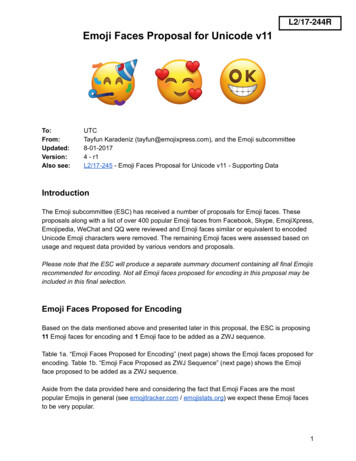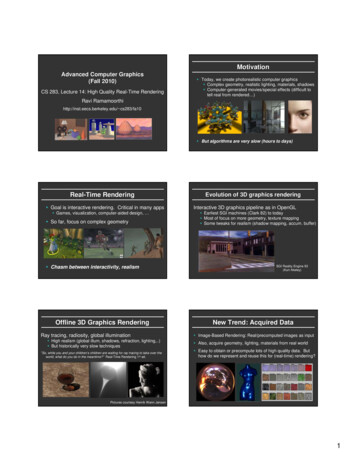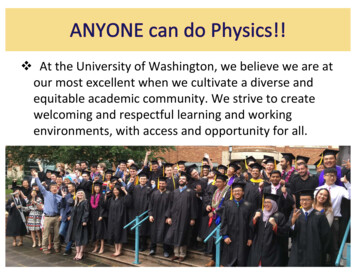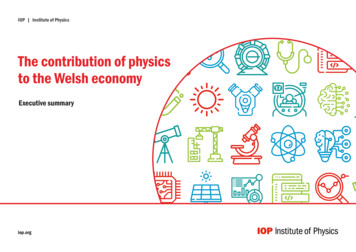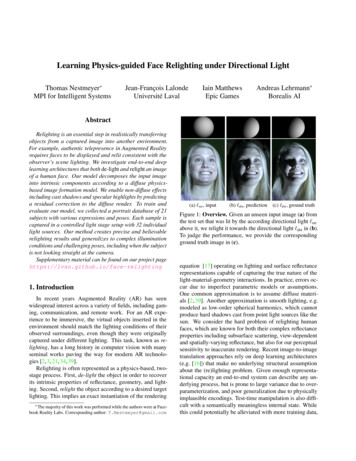
Transcription
Learning Physics-guided Face Relighting under Directional LightThomas Nestmeyer MPI for Intelligent SystemsJean-François LalondeUniversité LavalIain MatthewsEpic GamesAndreas Lehrmann Borealis AIAbstractRelighting is an essential step in realistically transferringobjects from a captured image into another environment.For example, authentic telepresence in Augmented Realityrequires faces to be displayed and relit consistent with theobserver’s scene lighting. We investigate end-to-end deeplearning architectures that both de-light and relight an imageof a human face. Our model decomposes the input imageinto intrinsic components according to a diffuse physicsbased image formation model. We enable non-diffuse effectsincluding cast shadows and specular highlights by predictinga residual correction to the diffuse render. To train andevaluate our model, we collected a portrait database of 21subjects with various expressions and poses. Each sample iscaptured in a controlled light stage setup with 32 individuallight sources. Our method creates precise and believablerelighting results and generalizes to complex illuminationconditions and challenging poses, including when the subjectis not looking straight at the camera.Supplementary material can be found on our project pagehttps://lvsn.github.io/face-relighting1. IntroductionIn recent years Augmented Reality (AR) has seenwidespread interest across a variety of fields, including gaming, communication, and remote work. For an AR experience to be immersive, the virtual objects inserted in theenvironment should match the lighting conditions of theirobserved surroundings, even though they were originallycaptured under different lighting. This task, known as relighting, has a long history in computer vision with manyseminal works paving the way for modern AR technologies [2, 3, 21, 34, 39].Relighting is often represented as a physics-based, twostage process. First, de-light the object in order to recoverits intrinsic properties of reflectance, geometry, and lighting. Second, relight the object according to a desired targetlighting. This implies an exact instantiation of the rendering The majority of this work was performed while the authors were at Facebook Reality Labs. Corresponding author: T.Nestmeyer@gmail.com(a) src , input(b) dst , prediction(c) dst , ground truthFigure 1: Overview. Given an unseen input image (a) fromthe test set that was lit by the according directional light srcabove it, we relight it towards the directional light dst in (b).To judge the performance, we provide the correspondingground truth image in (c).equation [17] operating on lighting and surface reflectancerepresentations capable of capturing the true nature of thelight-material-geometry interactions. In practice, errors occur due to imperfect parametric models or assumptions.One common approximation is to assume diffuse materials [2, 39]. Another approximation is smooth lighting, e.g.modeled as low-order spherical harmonics, which cannotproduce hard shadows cast from point light sources like thesun. We consider the hard problem of relighting humanfaces, which are known for both their complex reflectanceproperties including subsurface scattering, view-dependentand spatially-varying reflectance, but also for our perceptualsensitivity to inaccurate rendering. Recent image-to-imagetranslation approaches rely on deep learning architectures(e.g. [16]) that make no underlying structural assumptionabout the (re)lighting problem. Given enough representational capacity an end-to-end system can describe any underlying process, but is prone to large variance due to overparameterization, and poor generalization due to physicallyimplausible encodings. Test-time manipulation is also difficult with a semantically meaningless internal state. Whilethis could potentially be alleviated with more training data,
acquiring sufficient amounts is very time consuming.Recent approaches have demonstrated that explicitly integrating physical processes in neural architectures is beneficial in terms of both robust estimates from limited dataand increased generalization [25, 39, 43]. However, these approaches have focused on the de-lighting process, and use thesimplified physical models for relighting that do not modelnon-diffuse effects such as cast shadows and specularities.In this work, we bridge the gap between the expressiveness of a physically unconstrained end-to-end approach andthe robustness of a physics-based approach. In particular, weconsider relighting as an image-to-image translation problem and divide the relighting task into two distinct stages: aphysics-based parametric rendering of estimated intrinsiccomponents, and a physics-guided residual refinement. Ourimage formation model makes the assumption of directionallight and diffuse materials. The subsequent refinement process is conditioned on the albedo, normals, and diffuse rendering, and dynamically accounts for shadows and any remaining non-diffuse phenomena.We describe a neural architecture that combines thestrengths of a physics-guided relighting process with theexpressive representation of a deep neural network. Notably,our approach is end-to-end trained to simultaneously learn toboth de-light and relight. We introduce a novel dataset of human faces under varying lighting conditions and poses, anddemonstrate our approach can realistically relight complexnon-diffuse materials like human faces. Our directional lighting representation does not require assumptions of smoothlighting environments and allows us to generalize to arbitrarily complex output lighting as a simple sum of point lights.To our knowledge, this is the first paper showing realisticrelighting effects caused by strong directional lighting, suchas sharp cast shadows, from a single input image.2. Related workIntrinsic images. Intrinsic image decomposition [3] andthe related problem of shape from shading [57] have inspiredcountless derived works. Of interest, [2] propose to simultaneously recover shape, illumination, reflectance and shadingfrom a single image and rely on extensive priors to guidean inverse rendering optimization procedure. Other methods recover richer lighting representations in the form ofenvironment maps given the known geometry [26]. More recent approaches rely on deep learning for the same task, forexample using a combination of CNN and guided/bilateralfiltering [31] or a pure end-to-end CNN approach [10] withthe common problem of hard to come by training data. Available datasets may include only sparse relative reflectancejudgements [4], or sparse shading annotations [20], whichlimits learning and quantitative evaluation.While many previous works focus on lighting estimationfrom objects [2, 12, 26, 29] or even entire images [11, 15, 18,54, 55], few papers explicitly focus on the relighting problem. Notably, [36] use a small number of images as input,and, more recently, [52] learn to determine which set of fivelight directions is optimal for relighting. Image-to-imagetranslation [16] combined with novel multi-illuminationdatasets [30] has lately demonstrated promising results infull scene relighting.The explicit handling of moving hard shadows in [9]and [35] is relevant. While both use multi-view inputs torelight outdoor scenes, our method works on a single inputimage to relight faces (our multi-view setup is only used tocapture training data). Similar to our work, [53] regress tointrinsic components like albedo and normals, but their illumination model is spherical harmonics and therefore doesnot handle shadows. [38] recently proposed a residual appearance renderer which bears similarities to our learned residualin that it models non-Lambertian effects. Both of the latter works optimize for intrinsic decomposition, whereas welearn end-to-end relighting. Our intrinsic components areonly used as a meaningful intermediate representation.Face relighting. Lighting estimation from face images often focuses on normalization for improving face recognition.For example, [50] use spherical harmonics (SH) to relight aface image, and [47] use a Markov random field to handlesharp shadows not modeled by low-frequency SH models.Other face modeling methods have exploited approximatelighting estimates to reconstruct the geometry [23, 45] ortexture [24]. In computer graphics similar ideas have beenproposed for face replacement [5,8]. Low-frequency lightingestimation from a face has been explored in [19, 40, 41]. Incontrast, [32] note that eyes reflect our surroundings and canbe used to recover high frequency lighting. More closelyrelated to our work, [7] learn the space of outdoor lightingusing a deep autoencoder and combine this latent space withan inverse optimization framework to estimate lighting froma face. However, their work is restricted to outdoor lightingand cannot be used explicitly for relighting.Of particular relevance to our work, neural face editing [43] and the related SfSNet [39] train CNNs to decompose a face image into surface normals, albedo, and SHlighting. These approaches also impose a loss on the intrinsic components, as well as a rendering loss which ensuresthat the combination of these components is similar to theinput image. FRADA [22] revisited the idea of relightingfor improving face recognition with face-specific 3D morphable models (similar to [43]), while we do not imposeany face-specific templates. Single image portrait relighting [58] bypasses the need for decomposition, while stillestimating the illumination to allow editing. In a similarline of work, [44] capture faces in a light stage using onelight at a time, but then train using smoother illuminationsfrom image based rendering which leads to artifacts whenexposed to hard cast shadows or strong specularities. Re-
cently, [28] also used light stage data and train to relightto directional lighting as we do. However, their networkexpects a pair of images captured under spherical gradientillumination at test time, which can only be captured in alight stage. The portrait lighting transfer approach of [42]directly transfers illumination from a reference portrait toan input photograph to create high-quality relit images, butfails when adding/removing non-diffuse effects.3. ArchitectureThe following two sections first introduce an image formation process (Sec. 3.1) and then describe its integrationinto a physics-based relighting architecture (Sec. 3.2).3.1. Image formation processThe image formation process describes the physicsinspired operations transforming the intrinsic properties ofa 3D surface to a rendered output. The majority of physicsbased works are based on specific instantiations of the rendering equation [17],ZLo (ωo ) f (ωi , ωo )Li (ωi )hn, ωi i dωi , (1)ωi Ωwhere ωi , ωo are the incoming and outgoing light directions relative to the surface normal n at the surface pointXj . Li (ωi ) and Lo (ωo ) are the corresponding (ir)radiances,f (·, ·) is the BRDF describing the material’s reflectance properties, and hn, ωi i is the attenuating factor due to Lambert’scosine law.This model is often simplified further by assuming adiffuse decomposition into albedo a R and shading s R,a f (ωi , ωo ),[const.]Zs Li (ωi )hn, ωi i dωi .(2)(3)ωi ΩNon-diffuse effects. A realistic relighting approach mustrelax modeling assumptions to allow complex reflectanceproperties such as subsurface scattering, transmission, polarization, etc., and if using (2) specularities. Unfortunately,learning a spatially varying BRDF model f (ωi , ωo ) basedon a non-parametric representation is infeasible: assumingan image size of 512 768 and a pixelwise discretizationof the local half-angle space [27] would result in 1.7 1012parameters. Learning a low-dimensional representation interms of semantic parameters [6] seems like a viable alternative but is still prone to overfitting and cannot account forlight-material-interactions outside of its parametric space.We propose a hybrid approach and decompose f intotwo principled components, a diffuse albedo a and a lightvarying residual r:f (ωi , ωo ) a r(ωi , ωo ).(4)This turns (1) intoLo (ωo ) as Zωi Ωr(ωi , ωo )Li (ωi )hn, ωi i dωi . (5)For a light source with intensity I(ωi ), we can identifyLi (ωi ) I(ωi )v(ωi ), where v {0, 1} is the binary visibility of the light source. Under the assumption of a single directional light source from ωei , we integrate over one point only,so if we further write re(eωi , ωo ) r(ωei , ωo )I(eωi )hn, ωei i,we can re-formulate our rendering equation (1) toLo (ωo ) (as re(ωei , ωo )) · v(eωi ).(6)This will be the underlying image formation process in allsubsequent sections. While as captures much of the diffuseenergy across the image according to an explicit generativemodel, the residual re(eωi , ωo ) accounts for physical effectsoutside of the space representable by (2) and is modeledas a neural network (akin to [38]). We do not impose anyassumptions on r(eωi , ωo ), even allowing light subtraction,but do enforce a to be close to the ground truth albedo of adiffuse model which we obtain from photometric stereo [51].Discussion. While directional lights are conceptually simple, they lead to challenging relighting problems. Our combination of an explicit diffuse rendering process and a nondiffuse residual (with implicit shading) serves several purposes: (1) Describing most of the image intensities with aphysics-based model means the output image will be moreconsistent with the laws of physics; (2) Describing specular highlights as residuals alleviates learning with a CNN;(3) Leaving the residual unconstrained (up to ground truthguidance) allows us to model effects that are not explainable by the BRDF, such as subsurface scattering and indirectlight; (4) Modeling visibility explicitly helps, because thesimple diffuse model does not handle cast shadows. At thesame time, expecting the residual to take care of shadowremoval by resynthesis is much harder than just masking it.3.2. Physics-guided relightingPresented with an input image Isrc that was lit by an inputillumination src , our goal is to learn a generator G, relightingIsrc according to a desired output illumination dst ,G(Isrc , src , dst ) Idst .(7)At training time, we assume src and dst to be directionallights, which is known to be a particularly challenging instance of relighting and accurately matches our captureddata (see Sec. 4). At test time, this is not a limitation, sincewe can easily fit a set of directional lights to an environmentmap to perform more complex relighting (see Sec. 6).Our physics-guided approach to solving the relightingtask consists of a recognition model inferring intrinsic components from observed images (de-lighting) and a generative
residualU-Netalbedodiffuse relightingstage 1modalitiesNimagelight (src)coordinatesU-Net latexit sha1 base64 "xDAozWG4RZdeBHH4WH/2eGf32c4 " qNK2/WHVtrZ3dvfq 42Dw UlHBH/QyJl6EQk4DipE21LTVdiOk537g aTUMvLNZZ5UrWs5 Z82SXRw46WUx4kmHK gDwYAgyfwAl7Bm/VufVpf1vfqtGaVP6egMtbPL0i/rBU /latexit sha1 base64 "NHMYMFE0XNh90PNmnNxm4H9lxAg " y2m3TpZhN2N2oJ Sle9S949G948SZe/Qlu2h5M64MHw8x7zDB QSz0cmXN2b8fGYqknEW yozmrhCRIIK11XySUUKJlQ/JSXWcLnuUqkH wwu8Gm/Gp/FlfC9ON4zlzzGUxvj5BYFCrXw /latexit sha1 base64 "juzMr1lbTbgFDgNOMN6bUJ84 iU " lsN z3c8GkSKhkSOjZbVtoox14G9BK2OcVt9h8 dy0yJ6Zp5qZmH4k9HJlFuzfjxSFUs5DT1/mSeWqlpP/aaNE ZduSnmcKMLxwshPmKkiMy/CnFBBsGJzDRAWVGc18RQJhJWuq MTgBZ8AGF6ADrkEX9AAGD AJvIBX AY/4Rf8XpxW4PLnCJQG/vwCKOeuig /latexit latexit sha1 base64 "Tnxd95Y8p2FkDUq/SjNv3yVhr3A " vNpl26P2F3I5aQZ/Cqr DTeJNefRK3aQ6mdWBhmPk vtkJE0a1cd2ls7O7t39wWDuqH580Ts arfO o 5HndFuht1rVN rcdz 14T16765ZV1sAluAI3wAN3oAseQQ/4AAMK3sA7 HA nS/n21muR3eccucCVOD8/AJYwqaR /latexit sha1 base64 "HCs3GnpdD4kUcOE1A6ESLnzcJL8 " y3C2zY7ja7WyNp gxe9eAL DTeDFcfwrPbwsGCk2wymfm cJkppiRtLKIFYkQniGJqRvKEchUcMkT5vaF0YJ7LGQ5nFt5 1 /Wh/VpfVmL5WjJWu2cQgHW9y89b6hj /latexit sha1 base64 "au q0C2vq1btjuhQr37QbsXrCkI " aV47itVceObAeoojwDK0g8AU/DhrqysrOCm3YgLSdZOt19n77z RGjStv2FK6tb2xuFYrbpZ3d8t5 pLsrSpdWKUwBoIaR7XVqb 3UhQqNQk9M1kiPRILXsz8T vG vBhZdQHsWacDw/NIiZpYU1 7oVUEmwZhNDEJbUZLXwCEmEtSkod2UoUTSi OQQNcgyZwAQYUPIFn8ALf4Dv8gNP56Bpc7ByCHODnL3v8qxQ /latexit diffuse relightingnormalsshading (dst)(a) Stage 1: Diffuse Rendering.L latexit sha1 base64 "Ty60nmDbLwomp/q3Is4lbeV464U " KEFbVZHTxDCmFjSypdiRSKZxQ/Z2WViDxXSQx4VrMFeut1bZL Vdtz29691 U1AC/PkF6keoaA /latexit sha1 base64 "MKVg5IdSVGm3OFtFBRymWVJ97RY " AAACLHicbVC9TsMwGPwCFEqh0MLIElEhMVUJC4yVWBgLoj vP5MaNKO86ntbG5VdreKe9W9varB4e1 lFXRYnEpIMjFsm 2Tqy59 QW6q3Wtk fS9GN6zlzjEUYP38AiLZqc8 /latexit sha1 base64 " Ks rc7yG0R4YfPYe8P9OBQNPFs " W4TmrVj8h2EFWUr2CFiZ0v4DNYEGLlO3AfA2k5kqWjc 7VPT5BzKg2rvsJCxubxa3t0k55d6 NJUijszjYnPUSRoSDEyVrofBDSSMUv0sFp3G 4czjrxlqTerN4W3 GraA1rsDIYSZxwIgxmSOu 8ASewQt8gx/wC34vRgtwuXMEcoA/v8pvqt0 /latexit imagelight (src)coordinatesN latexit sha1 base64 "xDAozWG4RZdeBHH4WH/2eGf32c4 " qNK2/WHVtrZ3dvfq 42Dw UlHBH/QyJl6EQk4DipE21LTVdiOk537g aTUMvLNZZ5UrWs5 Z82SXRw46WUx4kmHK gDwYAgyfwAl7Bm/VufVpf1vfqtGaVP6egMtbPL0i/rBU /latexit sha1 base64 "NHMYMFE0XNh90PNmnNxm4H9lxAg " y2m3TpZhN2N2oJ Sle9S949G948SZe/Qlu2h5M64MHw8x7zDB QSz0cmXN2b8fGYqknEW yozmrhCRIIK11XySUUKJlQ/JSXWcLnuUqkH wwu8Gm/Gp/FlfC9ON4zlzzGUxvj5BYFCrXw /latexit sha1 base64 "juzMr1lbTbgFDgNOMN6bUJ84 iU " lsN z3c8GkSKhkSOjZbVtoox14G9BK2OcVt9h8 dy0yJ6Zp5qZmH4k9HJlFuzfjxSFUs5DT1/mSeWqlpP/aaNE ZduSnmcKMLxwshPmKkiMy/CnFBBsGJzDRAWVGc18RQJhJWuq MTgBZ8AGF6ADrkEX9AAGD AJvIBX AY/4Rf8XpxW4PLnCJQG/vwCKOeuig /latexit final relightingGT capturevisibility(b) Stage 2: Non-Diffuse Residual.Figure 2: Physics-guided relighting with structured generators. Our generator consists of two stages modeling diffuseand non-diffuse effects. All intrinsic predictions are guided by losses w.r.t. photometric stereo reconstructions. (a) We usea U-Net with grouped convolutions to make independent predictions of the intrinsic components. Predicted normals arealways re-normalized to unit vectors. Given a desired output lighting, we compute shading from normals and render a diffuseoutput. (b) Conditioned on all modalities inferred in (a), we predict a non-diffuse residual and binary visibility map to modelspecularities, cast shadows, and other effects not captured by our instance of the rendering equation.model producing relit images from intrinsic components (relighting). While the recognition model takes the form of atraditional CNN, the generative model follows our imageformation process (Sec. 3.1) and is represented by structuredlayers with clear physical meaning. In line with (6), we implement the latter as a two-stage process: (Stage 1) Using thedesired target lighting, we compute shading from predictednormals and multiply the result with our albedo estimate toobtain a diffuse render; (Stage 2) Conditioned on all intrinsicstates predicted in stage 1, we infer a residual image and avisibility map, which we combine with the diffuse renderaccording to (6). An illustration of this pipeline is shownin Fig. 2. Since all its operations are differentiable and directly stacked, this allows us to learn the proposed model inan end-to-end fashion from input to relit result.We introduce losses for all internal predictions, i.e.,albedo, normals, shading, diffuse rendering, visibility, andresidual. We emphasize the importance of using the rightloss function and refer to Sec. 5.1 for a comprehensive study.In order to obtain the corresponding guidance during training, we use standard photometric stereo reconstruction [51].4. DataOur data comprises a diverse set of facial expressionscaptured under various lighting conditions.4.1. AcquisitionWe record our data in a calibrated multi-view light-stageconsisting of 6 stationary Sony PMW-F55 camcorders anda total of 32 white LED lights. The cameras record linearHDR images at 2048 1080 / 60 fps and are synchronizedwith a Blackmagic sync generator that also triggers the LEDlights. We flash one LED per frame and instruct our subjectsto hold a static expression for the full duration of an LEDcycle (32 frames 0.53 s). In order to remove captures withmotion, we filter our data based on the difference of two fullylit shots before/after each cycle. For light calibration, weuse a chrome sphere to recover directions and intensities in3D [13] but subsequently express them with respect to eachof the 6 cameras, such that we obtain a total of 6 · 32 192different light directions/intensities for each image.We record a total of 482 sequences from 21 subjects,resulting in 482 · 6 · 32 · 32 2,961,408 relighting pairs.Each pair is formed using any one of the 32 lights as input,and any one taken from the same sequence and same cameraas output. We split them into 81% (17 subjects) for training,9.5% (2 subjects) for validation and 9.5% (2 subjects) fortesting.1 We did not ask the subjects to follow any specificprotocol of facial expressions, besides being diverse, suchthat our evaluation on validation/test data is on both unseenexpressions and unseen subjects.After extraction of the raw data, we use photometricstereo (PMS) reconstruction [51] to separate the input images I into albedo A, shading S with corresponding normals,and non-diffuse residual images R I A S per frame.4.2. AugmentationModern neural architectures are much better at interpolation than extrapolation. It is therefore critical to coverthe space of valid light transports as well as possible. Tothis end, we perform a series of data augmentations stepsin an attempt to establish strong correlations throughout theparametric relighting space: (1) We flip all training imagesalong the horizontal and vertical axis, increasing the effec1 The split into training, validation and testing was done manually inan effort to balance the demographics of the subjects. See supplementarymaterial for details.
Table 1: Loss selection. We explore the influence of different training losses and evaluation metrics on direct image-toimage translation (“pix2pix”) and our structured guidanceapproach (“ours”). For each class, we show validation scoresfor all pairwise combinations of 5 training losses (rows) andthe same 5 evaluation metrics (columns). The best model foreach evaluation metric is shown in bold.ourspix2pixMEvaluation MS-DSSIM.0410.0055.2165.1470.0910[M: model; LPIPS: [56]; DSSIM: structured dissimilarity;MS-DSSIM: multi-scale DSSIM]tive dataset size by a factor of 4. Note that this also requiresadaptation of the corresponding light directions and normals;(2) We perform a linear scaling x0 s · x, s U[0.6,1.1] ,of the images, shading, residuals and light intensities. Inpractice, we did not observe substantial benefits compared totraining without scaling; (3) We randomly perturb the lightcalibration with Gaussian noise n N (0, 0.012 ) to improvegeneralization and account for minimal calibration errors;(4) For quantitative results, we perform a spatial rescalingto 18 th of the original image resolution (135 256), trainon random crops of size 128 128 and test on center cropswith the same resolution to have comparability with SfSNet.Qualitative results are generated by rescaling to 12 of theoriginal resolution (540 1024), trained on random crops ofsize 512 768 and tested on center crops of that resolution.5. ExperimentsOur models were implemented using PyTorch [33] with aU-Net [37] generator and PatchGAN [14] discriminator (forthe final relit image) based on the implementations providedby pix2pix [16]. The images in our dataset are camera RAW,represented as 16-bit linear RGB values nominally in therange [0, 1]. There is under- and over-shoot headroom, butfor training and evaluation we clamp them into this rangeand linearly transform to [ 1, 1] as input into the network.5.1. Evaluation metricQuantitatively comparing the relit prediction Iˆdst of thegenerator against the ground truth Idst requires an appro-priate error measure. We consider the L1 and L2 normsbut recognize that they do not coincide with human perceptual response. We also consider the “Learned PerceptualImage Patch Similarity” (LPIPS) loss suggested by [56] using the distance of CNN-features pretrained on ImageNet.Another prevailing metric of image quality assessment isstructural similarity (SSIM) [48] and its multi-scale variant(MS-SSIM) [49]. In our evaluation, we use the corresponding dissimilarity measure DSSIM 1 SSIM, and likewise2for MS-SSIM, to consistently report errors.When defining the loss function during training, the samechoices of distance metrics are available. To densely evaluate their performance, we report in Table 1 the results oftraining all intrinsic layers with the same loss function fromthe options above. Surprisingly, we conclude that, for ourtask, using DSSIM for the training loss consistently leads tomodels which generalize better on the validation set usingmost of the error metrics. The only exception is evaluationusing the LPIPS metric, which is better when also trainedusing this metric. Therefore, we chose the models trained onDSSIM for computing the final test results.5.2. Baseline comparisonsWe now provide quantitative and qualitative comparisonsof our proposed architecture, to related work.5.2.1BaselinesOur baselines comprise the following set of related methods.PMS. To understand the lower error bound of a diffusemodel, we take albedo A and shading S from photometricstereo (PMS; [51]) and diffuse render via A S. We notethat this model has access to all light configurations at thesame time, with the desired target illumination amongst them.Since this gives an unfair advantage, we do not highlightresults for this model in Table 2.SfSNet (pretrained). We take the pretrained network ofSfSNet [39] and apply it to our data by usi
to directional lighting as we do. However, their network expects a pair of images captured under spherical gradient illumination at test time, which can only be captured in a light stage. The portrait lighting transfer approach of [42] directly transfers illumination from a reference portrait
